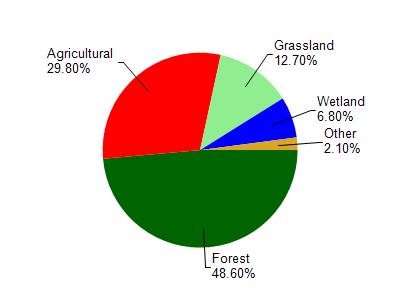Jackson
Yes
No
No
Fish and Aquatic Life
Overview
French Creek is a ten-mile-long tributary to the Trempealeau River in jackson County. The entire stream is a Class I Trout water. French Creek is not a WWSF but Class II and III trout stream (1980 Trout Book). 2002 data indicates the stream is supporting a Coldwater A community found in a Class I trout stream
Date 2002
Author Aquatic Biologist
Impaired Waters
French Creek in Jackson County was on the 303d list for Sediment/Total Suspended Solids causing elevated water temperature. In 1998, at the time of listing, the water had an existing use of warm water forage fish, a potential use of Cold III and a codified use of warm water sport fish.
According to the 1980 blue trout stream book, French Creek is codified as a Class II and Class III trout stream. In the 2002 trout stream book, the classification of French Creek was changed to Class I for the entire length indicating a better fishery exists in the stream than what was codified in 1980. Fishery data collected in 2002 indicate multiple year classes of trout including young of the year were found in French Creek which supports the Class I attainable use. Habitat conditions and water temperatures are adequate to support a cold water fishery with reproducing brook trout. This stream should not have been placed on the 303d list and was removed in 2008.
Date 2008
Author Aquatic Biologist
Condition
Wisconsin has over 84,000 miles of streams, 15,000 lakes and milllions of acres of wetlands. Assessing the condition of this vast amount of water is challenging. The state's water monitoring program uses a media-based, cross-program approach to analyze water condition. An updated monitoring strategy (2015-2020) is now available. Compliance with Clean Water Act fishable, swimmable standards are located in the Executive Summary of Water Condition in 2018. See also the 'monitoring and projects' tab.
Reports
Management Plans
Maintenance of French Creek as a Class I trout water is the primary management goal.
Date 2011
Author Aquatic Biologist
Monitoring
Monitoring the condition of a river, stream, or lake includes gathering physical, chemical, biological, and habitat data. Comprehensive studies often gather all these parameters in great detail, while lighter assessment events will involve sampling physical, chemical and biological data such as macroinvertebrates. Aquatic macroinvertebrates and fish communities integrate watershed or catchment condition, providing great insight into overall ecosystem health. Chemical and habitat parameters tell researchers more about human induced problems including contaminated runoff, point source dischargers, or habitat issues that foster or limit the potential of aquatic communities to thrive in a given area. Wisconsin's Water Monitoring Strategy was recenty updated.
Grants and Management Projects
| Project Name (Click for Details) | Year Started |
|---|
|
|
Monitoring Projects
| WBIC | Official Waterbody Name | Station ID | Station Name | Earliest Fieldwork Date | Latest Fieldwork Date | View Station | View Data |
|---|
| 1802900 | French Creek | 10009705 | French Creek 3 | 1/1/2015 | 1/1/2015 | Map | Data |
| 1802900 | French Creek | 10016685 | French Creek - 10 Feet Above Bridge On Post Road | 10/1/1991 | 10/1/1991 | Map | Data |
| 1802900 | French Creek | 10009704 | French Creek 1 | | | Map | Data |
|

Watershed Characteristics
French Creek is located in the Upper Trempealeau River watershed which is 175.54 mi². Land use in the watershed is primarily forest (48.60%), agricultural (29.80%) and a mix of grassland (12.70%) and other uses (8.90%). This watershed has 359.69 stream miles, 209.54 lake acres and 7,549.82 wetland acres.
Nonpoint Source Characteristics
This watershed is ranked Not Available for runoff impacts on streams, Not Available for runoff impacts on lakes and High for runoff impacts on groundwater and therefore has an overall rank of High. This value can be used in ranking the watershed or individual waterbodies for grant funding under state and county programs.However, all waters are affected by diffuse pollutant sources regardless of initial water quality. Applications for specific runoff projects under state or county grant programs may be pursued. For more information, go to surface water program grants.